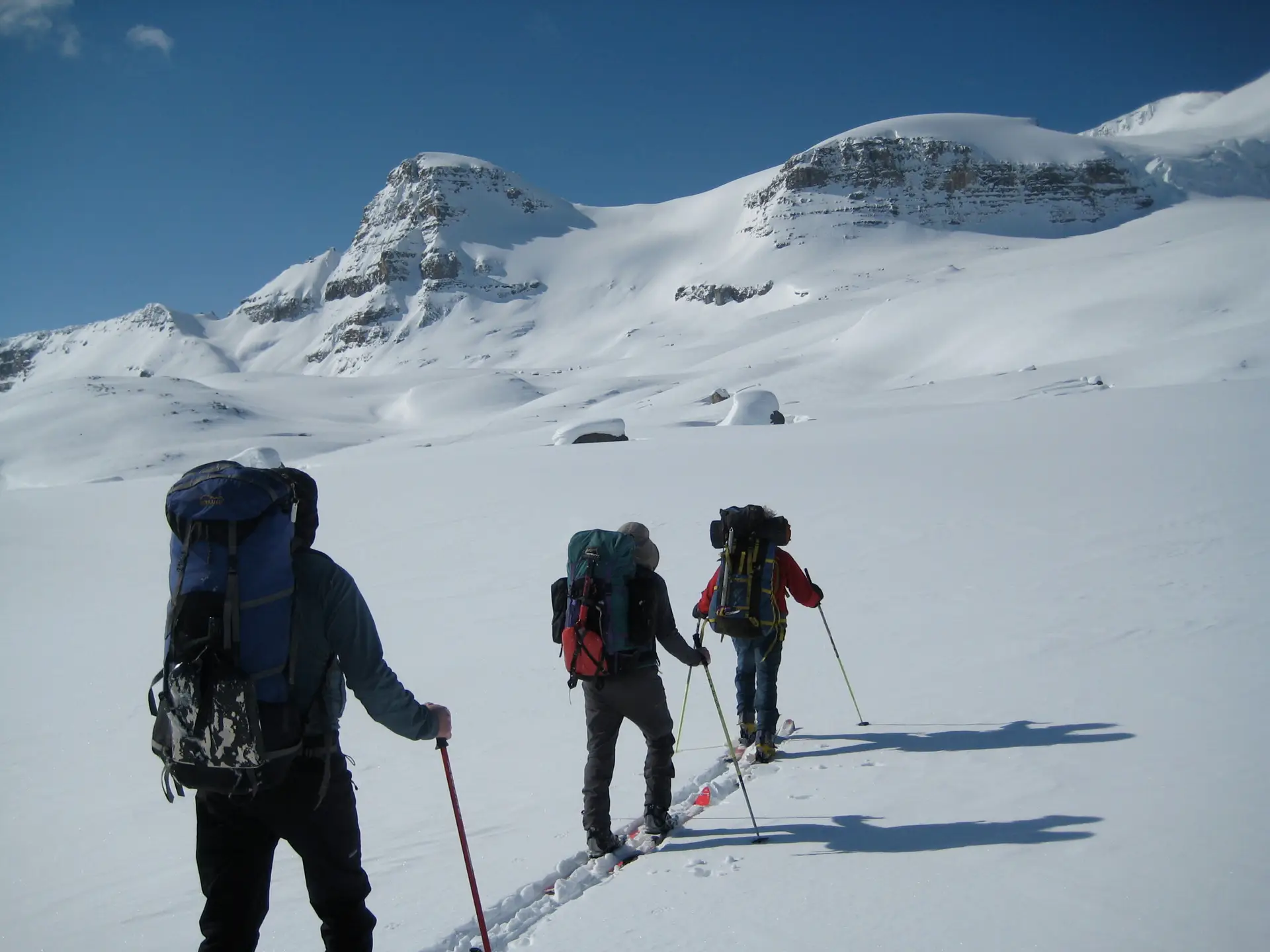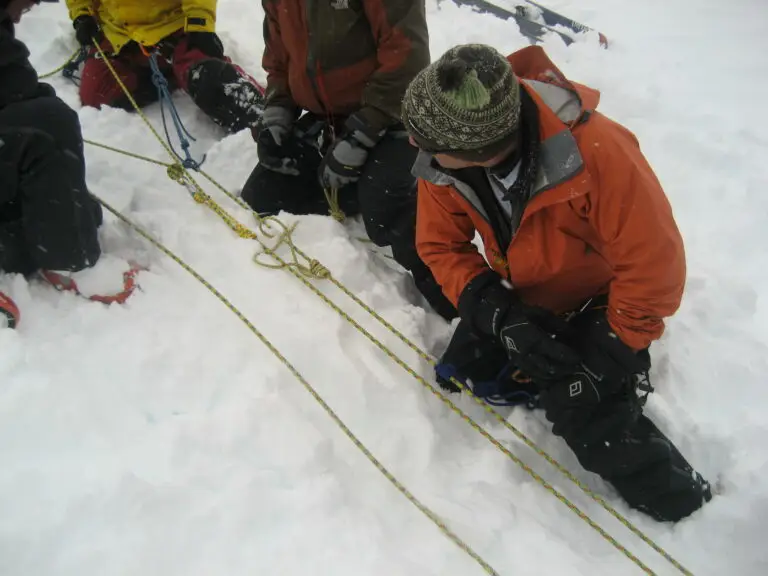No previous mountaineering experience is required, however, you must have backcountry skiing/splitboarding experience and be able to comfortably ski the equivalent of blue/intermediate runs at downhill ski areas in variable conditions (powder, crust, icy etc.) with a heavy pack. Familiarity with touring equipment and the use of avalanche transceivers is also essential as is good all round fitness. You need to be capable of skinning uphill for several hours with a 35-40lb pack.
If you have any concerns about your suitability for this camp please contact the office before registering.
Before registering, please review our Trip Waivers and Liability, and Cancellation Policies.
Camps are subject to minimum enrollment in order to run.
Crossing the Wapta Icefield east to west rather than north to south, the Bow-Yoho traverse is less publicized than the Wapta. But we have no idea why because this adventure offers the same great hut experience, exciting glaciated terrain and spectacular summits in arguably a more peaceful and isolated setting.
This route will take you over two additional glaciers (Yoho and des Poilus) to the Wapta Icefield, making it perfect for those who have been on the Wapta already and are seeking something new. The Yoho Valley is a particular gem, hosting iconic summits such as the President, Vice President, Mt. McArthur, fairytale log cabin accommodation (the Stanley Mitchell hut) and typically more powder than the Wapta. There’s a reason Chic Scott calls a visit here the “quintessential Canadian Rockies ski experience”.
Let us take care of everything from the huts, to the guiding, to the catering and and join us on a true ACC Adventure this winter!

Guides for this trip are still being confirmed.
Our ACMG certified ski or full mountain guides will ensure your adventure is both safe and enjoyable. Our guides will be welcome to answering questions about the region as well as everything from ski technique to gear.
The ACC hires guides certified by the Association of Canadian Mountain Guides (ACMG). Visit the ACMG website to learn more about what they do!
*Guiding Staff for a trip sometimes have to be swapped out due to unavoidable circumstances. In this event ACC staff with contact you as soon as possible to update you on any changes to trip staffing
Everyone on your camp will travel across the icefields together, but there is flexibility in the itinerary to accommodate individual objectives such as learning skills in glacial travel, bagging winter summits, completing a first major ski traverse, or even hunting powder.
There will be time and opportunities to summit some coveted peaks. Possible ski-mountaineering objectives include:
Many of these mountains can be skied directly from the summit!
Other highlights of the trip include passing the beautiful Takakkaw Falls frozen in its winter coat, and the potential to ski both President’s Pass and the Iceline Exit from the Stanley Mitchell Hut.
Return to civilization to Emerald Lake or the Transcanada Highway either by the Iceline exit (a stunning, high elevation route) or down the Yoho Valley road past Takakkaw Falls (the second tallest waterfall in Canada). Debrief with your guides and head home with life long memories.
You can extend your trip and depart from the Stanley Mitchell hut a day later on April 19th 2025. To enjoy the excellent skiing around the Hut.
I felt like this course was so much more than a simple, care-free, powder backcountry skiing course and bridged the gap into mountaineering as well.
I felt like this course was so much more than a simple, care-free, powder backcountry skiing course and bridged the gap into mountaineering as well.

Evenings will be spent enjoying great food, socializing in cozy hut surroundings and resetting for the next day’s skiing. Food supplies will be carried in by porter to reduce pack weights and increase the quality and enjoyment of skiing. There will be a mix of lightweight but nutritious backpacking meals and snacks to keep you properly fuelled and hydrated for your adventure. All of the food for this camp is provided by specialized backcountry supplier Peak Eats.
Completing the Bow-Yoho wouldn’t be the same without also getting the full ACC hut experience. You’ll visit three very different styles of hut – the Bow, Guy and Stanley Mitchell – with two nights at each. The Bow Hut is by far the largest and most accessible of the huts, you can expect day and overnight trippers here and a social vibe. The Guy offers modern comfort in a spectacular location; until 2016, the traverse required camping at this location so this addition has made the traverse more accessible and comfortable for ski tourers. The Stanley Mitchell is a classic log-style, cozy cabin built in 1940. Staying here is an experience in itself with fantastic views across the mountains and communal and social dining. Guests will be expected to assist the guides with hut duties such as collecting snow for water helping with dishes.
If you don't have everything on the gear list and aren't ready to invest in your own, there are many awesome local businesses that rent out all of the equipment you will need. Be sure to reserve your rentals ahead of time to make sure everything you need is available for you when you need it.
Coming from the Bow Valley? Check out Gear Up in Canmore. ACC members get 10% off all gear rentals!Cornices and crevasses. Trees, tree wells, and tree stumps. Cliffs, creeks, rocks and boulders. Holes and depressions below the snow surface. Variable and difficult snow conditions. Snowcat roads and road ranks. Fences and other man-made structures. Impact or collision with other persons, vehicles or objects. Encounters with domestic or wild animals. Loss of balance or control. Becoming lost or separated from the group. Slips, trips, and falls.
Mitigated by Trained and experienced Guide.
The use of Radios.
Slips trips and falls indoor or outdoor. Equipment failure. Infectious disease contracted through viruses, bacteria, parasites, and fungi which may be transmitted through direct or indirect contact. Negligence of other persons, including other guests. Negligent first aid. Negligence of the guide Including failure to take reasonable steps to safeguard or protect you from, or warn you of risk, dangers, hazards, on participating in ACC activities
Developed safety plans and procedures with decades of experience managing risk.
Avalanches can occur in the terrain you will be entering. Caused by natural forces, or by people travelling through the terrain (skiing/snowboarding). Anyone caught in an avalanche is at risk of personal injury, death, and/or property damage or loss.
Certified Guides with experience and training to manage this risk.
Daily risk assessment processes.
Guest training
Mountaineering and ice climbing present the risk of falling from the wall causing the climber to collide with the wall or ground which can lead to injury or death. The risk of a belay failure is also present which can contribute to a ground fall.
Reviewing best practices with the guide.
Equipment checks
Communication can be difficult and in the event of an accident, rescue and treatment may not be available. Adverse weather may also delay the arrival of treatment and transport out of the field. If an Injury occurs in challenging terrain movement to an evacuation point may be slow.
First Aid / Rescue Training.
Satellite Communications
Even when set up correctly, a ski binding might not release during every fall or may release unexpectedly. The ski boot/binding system is no guarantee that the skier will not be injured. Non-DIN-certified bindings, such as pin/tech bindings, present a higher risk of pre-release and/or injury as they are not designed to the same safety standards as a DIN-certified alpine binding.
Unlike alpine ski boot/binding systems, snowboard and some telemark boot/binding systems are not designed or intended to release and will not release under normal circumstances. Using such a system increases the risk of injury and/or death when caught in an avalanche.
None

We appreciate that the lands known today as Canada are home to the enduring presence of all First Nations and Métis people, and the Inuit and we acknowledge the past, present, and future generations of these Nations who continue to lead us in stewarding this land, as well as honour their knowledge and cultural ties to this place. The Alpine Club of Canada’s head office is located in the traditional lands of Treaty 7, which is comprised of the Stoney Nakoda Nations of Wesley, Chiniki, and Bearspaw; three Nations of the Blackfoot Confederacy: the Piikani, Kainai, and Siksika; the Mountain Cree; and the Tsuu T’ina of the Dene people. This territory is also shared with the Métis Nation of Alberta, Region III. Before the signing of Treaty 7, and prior to the establishment of provincial boundaries, this region was also used by the Ktunaxa and the Maskwacis people.
General Inquiries
Phone: 403-678-3200
Email: [email protected]
201 Indian Flats Rd.
PO Box 8040 Main St, Canmore, AB, T1W 2T8, Canada
Office Hours: Monday – Friday, 9am – 5pm
The Alpine Club of Canada is a registered Amateur Athletic Association and a registered Canadian charity (Registration No: 10670 4182 RR0001). The ACC’s US Foundation can accept charitable donations from donors living in the United States. We will issue a charitable tax receipt for eligible donations of $20 or more.